NVIDIA's GeForce GTX 580: Fermi Refined
by Ryan Smith on November 9, 2010 9:00 AM ESTCompute and Tessellation
Moving on from our look at gaming performance, we have our customary look at compute performance, bundled with a look at theoretical tessellation performance. Unlike our gaming benchmarks where NVIDIA’s architectural enhancements could have an impact, everything here should be dictated by the core clock and SMs, with shader and polymorph engine counts defining most of these tests.
Our first compute benchmark comes from Civilization V, which uses DirectCompute to decompress textures on the fly. Civ V includes a sub-benchmark that exclusively tests the speed of their texture decompression algorithm by repeatedly decompressing the textures required for one of the game’s leader scenes.
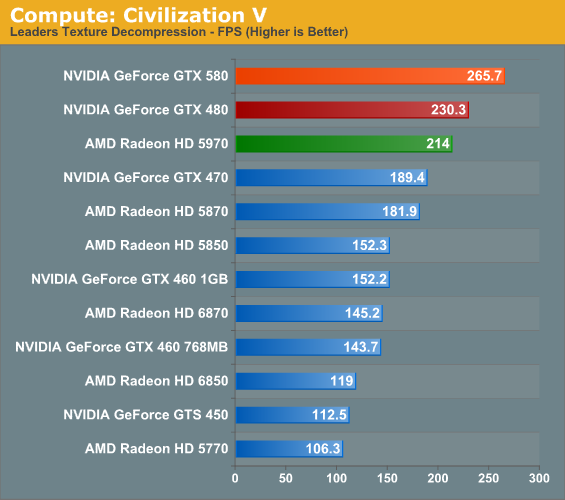
We previously discovered that NVIDIA did rather well in this test, so it shouldn’t come as a surprise that the GTX 580 does even better. Even without the benefits of architectural improvements, the GTX 580 still ends up pulling ahead of the GTX 480 by 15%. The GTX 580 also does well against the 5970 here, which does see a boost from CrossFire but ultimately falls short, showcasing why multi-GPU cards can be inconsistent at times.
Our second compute benchmark is Cyberlink’s MediaEspresso 6, the latest version of their GPU-accelerated video encoding suite. MediaEspresso 6 doesn’t currently utilize a common API, and instead has codepaths for both AMD’s APP (née Stream) and NVIDIA’s CUDA APIs, which gives us a chance to test each API with a common program bridging them. As we’ll see this doesn’t necessarily mean that MediaEspresso behaves similarly on both AMD and NVIDIA GPUs, but for MediaEspresso users it is what it is.
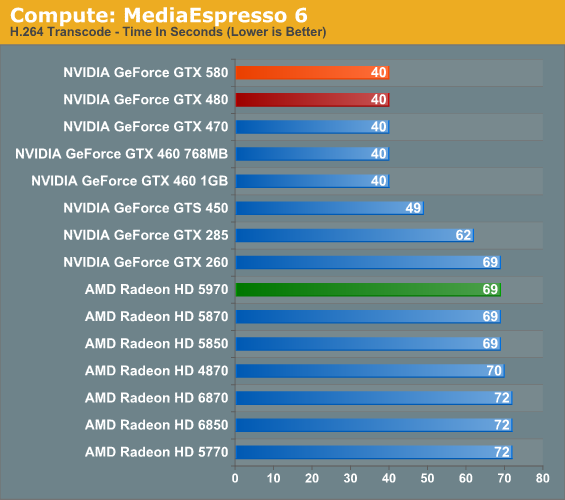
We throw MediaEspresso 6 in largely to showcase that not everything that’s GPU accelerated is GPU-bound, as ME6 showcases this nicely. Once we move away from sub-$150 GPUs, APIs and architecture become much more important than raw speed. The 580 is unable to differentiate itself from the 480 as a result.
Our third GPU compute benchmark is SmallLuxGPU, the GPU ray tracing branch of the open source LuxRender renderer. While it’s still in beta, SmallLuxGPU recently hit a milestone by implementing a complete ray tracing engine in OpenCL, allowing them to fully offload the process to the GPU. It’s this ray tracing engine we’re testing.
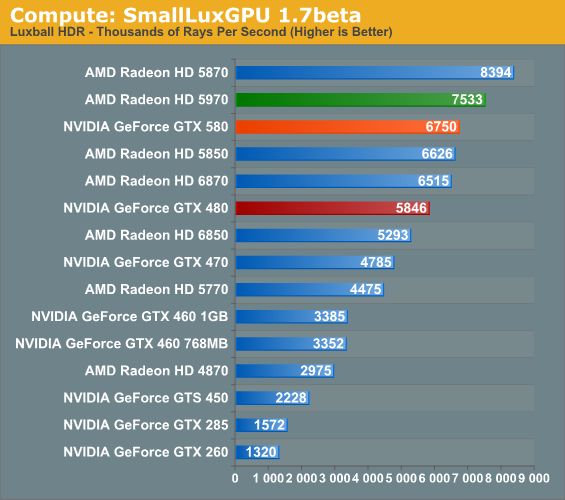
SmallLuxGPU is rather straightforward in its requirements: compute and lots of it. The GTX 580 attains most of its theoretical performance improvement here, coming in at a bit over 15% over the GTX 480. It does get bested by a couple of AMD’s GPUs however, a showcase of where AMD’s theoretical performance advantage in compute isn’t so theoretical.
Our final compute benchmark is a Folding @ Home benchmark. Given NVIDIA’s focus on compute for Fermi and in particular GF110 and GF100, cards such as the GTX 580 can be particularly interesting for distributed computing enthusiasts, who are usually looking for the fastest card in the coolest package. This benchmark is from the original GTX 480 launch, so this is likely the last time we’ll use it.
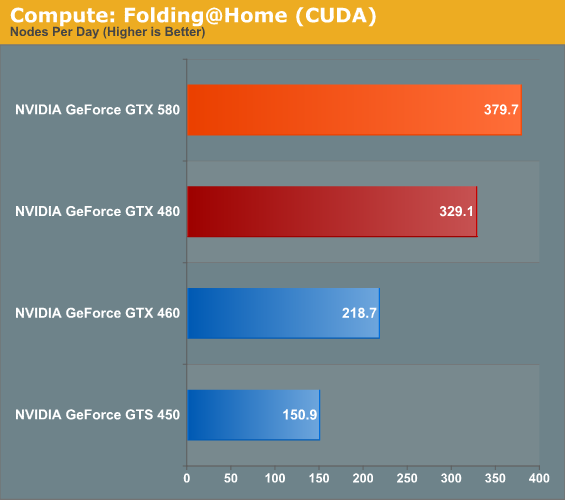
If I said the GTX 580 was 15% faster, would anyone be shocked? So long as we’re not CPU bound it seems, the GTX 580 is 15% faster through all of our compute benchmarks. This coupled with the GTX 580’s cooler/quieter design should make the card a very big deal for distributed computing enthusiasts.
At the other end of the spectrum from GPU computing performance is GPU tessellation performance, used exclusively for graphical purposes. Here we’re interesting in things from a theoretical architectural perspective, using the Unigine Heaven benchmark and Microsoft’s DirectX 11 Detail Tessellation sample program to measure the tessellation performance of a few of our cards.
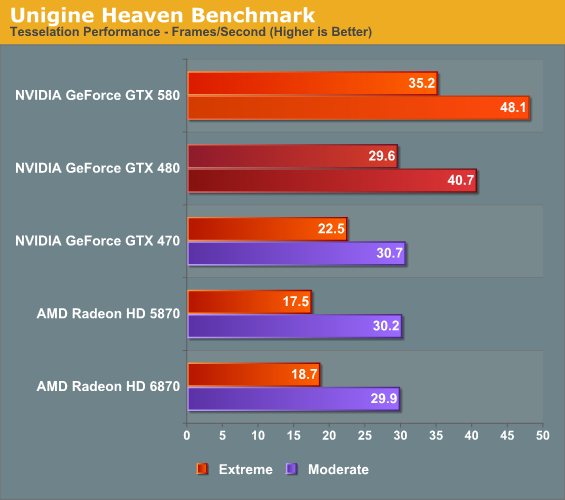
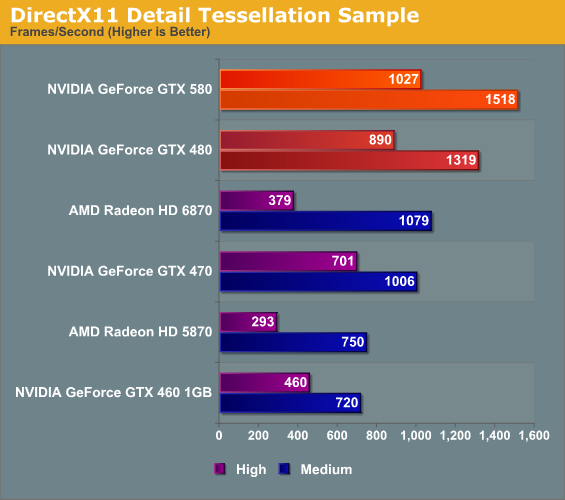
NVIDIA likes to heavily promote their tessellation performance advantage over AMD’s Cypress and Barts architectures, as it’s by far the single biggest difference between them and AMD. Not surprisingly the GTX 400/500 series does well here, and between those cards the GTX 580 enjoys a 15% advantage in the DX11 tessellation sample, while Heaven is a bit higher at 18% since Heaven is a full engine that can take advantage of the architectural improvements in GF110.
Seeing as how NVIDIA and AMD are still fighting about the importance of tessellation in both the company of developers and the public, these numbers shouldn’t be used as long range guidance. NVIDIA clearly has an advantage – getting developers to use additional tessellation in a meaningful manner is another matter entirely.










160 Comments
View All Comments
donjuancarlos - Tuesday, November 9, 2010 - link
Along that line it's shoo-in, not shoe-in. :)Ryan Smith - Tuesday, November 9, 2010 - link
In this house we obey the laws of thermodynamics!Thanks for the heads up, Don.
Troll Trolling - Tuesday, November 9, 2010 - link
You guys made my day.samspqr - Tuesday, November 9, 2010 - link
more important, where it says:"Both the Radeon HD 5970 and Radeon HD 6870 CF are worthy competitors to the GTX 580 – they’re faster and in the case of the 6870 CF largely comparable in terms of power/temperature/noise."
it should say:
"Both the Radeon HD 5970 and Radeon HD 6870 CF come out on top of the GTX 580 – they’re faster in nearly all benchmarks, and in both cases largely comparable in terms of price, power and temperature; 6870CF is also comparable in terms of noise, while 5970 comes out significantly louder."
DominionSeraph - Tuesday, November 9, 2010 - link
No, it should say, "Both 6850 CF and GTX460 SLI blow everything else out of the water given that they're practically giving away the highly overclockable 6850's for ~$185, 1GB GTX 460's for ~$180 AR, and 768MB GTX 460's for $145 AR."DreamerX5521 - Tuesday, November 9, 2010 - link
by looking at the test results, I guess 6870CF is a better choice than a single 580 in term of performance/watt, price (about the same), temperature, noise, etc..Kim Leo - Tuesday, November 9, 2010 - link
I noticed that as well, a little surprising I did expect a bit more considering all the hype, but then again it's built on the Fermi.I'm not sure what's up with the pricing? Do they think that there will be a market for GTX480 when Cayman comes and with the GF110 out?
Sihastru - Tuesday, November 9, 2010 - link
If you can live with the sub-par minimum framerates that plagues so many games with CF setups.JarredWalton - Tuesday, November 9, 2010 - link
Amen. I'm a 5850 CF user (and 4870X2 before that), and I can tell you I'd much rather have a single GPU and forget about profiles and other issues. But then, 30" LCDs need more than a single GPU in most games.B3an - Wednesday, November 10, 2010 - link
30" monitors dont need anything more than a high-end single GPU for most games. 99.9% of PC games are playable maxed out plus AA at 2560 res with just one of my 5870's in use, of with my previous 480. Theres only a handful of games that need dual GPU's to be playable at this res. Mainly because most games are console ports these days.And the OP is wrong, 6870 CF is not any better than the 580 with temperature or noise. 580 being better under load with noise, better with temps at idle, but only very slightly hotter under load.